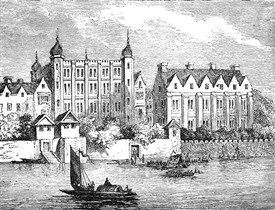The origins of Covent Garden

Salisbury and Worcester houses in 1630 from Haunted London
Covent Garden Community Assocation

Saxon brooch from credit Museum of London
Covent Garden Community Assocation
Covent Garden is an ancient part of England’s capital outside the original walled City of London, Roman ‘Londinium’. From Saxon times people lived and traded here, between the river and what is now Seven Dials. This settlement of ‘Lundenwic’ thrived from the 6th century, until Londinium was revived in the late 9th century. It then reverted mainly to pasture.
The area’s name comes from the ‘convent garden’ cultivated here in the Middle Ages by the monks of the Abbey of Westminster, who sold their surplus crops on the site. By the 14th Century the capital was expanding, with more demand for food. People began to bring their own produce to sell, creating the first idea of a market here.
Great houses were built along the river and the Strand, their supplies coming up the Thames. More modest dwellings began to appear across the meadows to the north, including those of people servicing the bishops and aristocracy.
The Abbey’s property was surrendered to Henry VIII upon its dissolution in 1539. By 1552 the former convent garden and its surrounding land had come into the hands of John Russell, later first Earl of Bedford, via the Crown. These 47 acres comprise the southern part of modern Covent Garden, being most of the land from the Strand northwards to Long Acre. The Bedfords built a grand home, Bedford House, but allowed a small market to grow outside its walls on the south side of what is now the Piazza.
The 3rd Earl of Bedford built along Long Acre around 1615. But the 4th Earl was more ambitious, and conceived really the first exercise in large-scale urban planning in Britain since the Romans. In 1630 he commissioned Inigo Jones, Surveyor of the King’s Works under Charles I, to enhance his estate. A central Piazza was built with colonnades and stately town houses, and, across 20 acres, new streets were added in a complementary style. Inspired by his travels in Italy, Jones introduced the idea of a uniform, elegant square which would set a pattern for much of the West End of London.
Courtiers, the gentry and successful men moved into the fashionable residences with their 10 foot ceilings. The parish of St. Paul’s was created for them in 1646, with its new church positioned like a temple in a Roman forum. Cottages standing in the way were demolished and the poorer classes moved on.
And so began what are now almost four centuries of competing property development interests, over these 100 or so acres of prime land that are home to the Covent Garden community.